Bill Hillman Presents
F.L.A.S.H.
Forces: Land ~ Air ~ Sea
~ Home
A MILITARY TRIBUTE WEBZINE
. . . AS YOU WERE . . .
www.hillmanweb.com/flash
Compiled by Bill Hillman
FLASH.
. . Editor and Webmaster: Bill Hillman: hillmans@wcgwave.ca

www.hillmanweb.com/rcaf/mag
FEBRUARY 2002
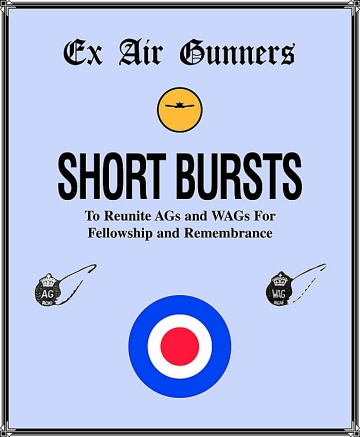
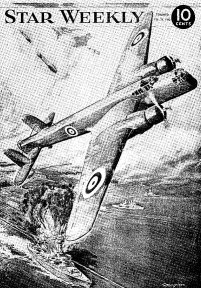
WHITLEY A/C
STAR WEEKLY magazine cover
Toronto February 24, 1940
(If anyone has specifications of the Whitley or flew in this machine,
please drop a line to the Editor of this Page.
Note the price of the magazine.)
The “Chuck” Singer
Revival
Here is how it started. The following
letter was received from Bob Singer:
Hi John,
I am trying to find some information to the unit
my father flew with in WW2. He was a crew member on a Sunderland Flying
boat shot down over Ireland during the war.
His name is Charles Singer. The call sign was eyeglass
eagle.
Any information on this available.
Thanks
Bob Singer
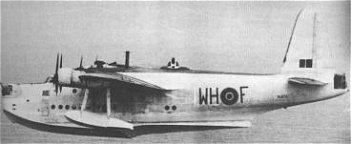
SUNDERLAND
As this took place in Ireland the members of 422 Sunderland
Squadron Association were contacted.
The book, LIFE AND TIMES of 422 Squadron page 64, sets
out the particulars of the crash.
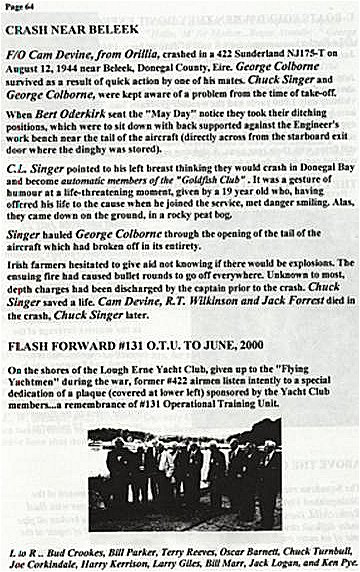
It will be noted that “Chuck Singer died later
of injuries."
When Bob Singer received this information he replied
expressing his appreciation, and added that his Dad, Charles Singer,
was alive and well in Florida.
Charles Singer sent the following:
John, Got so much to tell you, don't know where to begin.
First of all I am glad to be with the living, raised five great kids, one
of you have been in touch with, Bob. George Colborn had both legs broken
at the knees, the tail section landed on him and he was pinned under it.
When I was trying to free myself from the wreck I heard him scream for
help, blood was running down my face, my left arm was broken and I was
in shock. The second scream made me go back to try to help. In pulling
him free with my right arm I did some damage to my shoulder, after dragging
him clear I passed out. and laid there for some time, like all the others
waiting for help. The next day the Americans came across the border to
southern Ireland, put us all on stretchers, rushed us across the border
and flew us to the hospital in England in a .D C 3.
Can't say enough about our fine treatment in the hospital
in London. An R.A.F. doctor who took care of me couldn't make my break
knit, as it was so clean a break, so he came up with the idea of using
more than one blade in the saw and cut the cast around the break area,
pushed the cast together, sealed it and sent me back to my bed. The idea
was for me to stay awake for 48 hours and push with everything I had to
close the bones together. With the help of the Drs and nurses I stayed
awake, they took me for an x-ray and what do you know, it worked saving
me from having my leg cut open to do a bone graft to my humorus bone.
My rehab in Divadale in North Toronto was just as rewarding,
the nurses had me in the pool every day, pushing my forearm back against
the pool wall, after a few weeks I got a lot of my extension back, not
all but later was able to strengthen up that side of my body so I could
get a job on my discharge. At present I am on a ten percent pension, helps
a little, right?
Please try to have any of my crew members that are still
with us, to contact me, that is if it is possible.
F/S Chuck Singer
3055 Lucerne Pk. Dr.
Greenacres, Florida.
USA 33467 2030
Hoping to hear from you,
Chuck Singer.
Chuck graduated from #9 Mont Joli. He said that he
never told his family the particulars of his WW11 experiences and has never
talked about the war years.
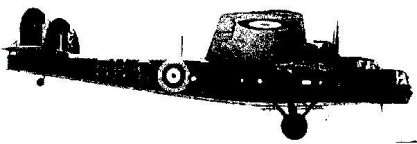
BOMBAY A/C 216 SQDN. DESERT OPS MAY 1941
The Bristol Bombay
– Jack-of-all-Trades
Never one of the glamorous aircraft of WWII –
the Bristol Bombay was ugly, slow, virtually unarmed, few in number and
out of sight in the vast desert for most of their operational career. But
the unique usefulness of the Bombay lay in its capability, in spite of
its size to land very short, on extremely rough ground, thanks to its high
wing and nose as well as its huge rugged, non-collapsible undercarriage
and big fat tires. Bombays were go-anywhere, do-anything, land-anyhow,
Jack-of-all-trades. This multi purpose versatility saw them tackle a gamut
of specialized roles during the four years of the desert campaign.
In 1940 when Mussolini attacked British forces in
the North African desert, 24 Bombays and Vickers Valencia biplanes were
the only ‘heavy’ bombers in the Middle East. As a result Bombays were the
first to bomb Axis Mediterranean ports, Tobruk, Derna, Benghazi, Tripoli,
etc. Throughout the successive campaigns, as battles moved back and forth,
up and down the desert, the Bombays kept the battle area supplied with
ammunition. The crews were in the vanguard of para-dropping – they also
pioneered landing and unloading large heavy loads on rough, unprepared
ground – where angels and prettier aircraft, feared to tread.
Bombays were in at the birth of the Special Air Service
(SAS) offspring of the Long Range Desert Group (LRDG) and assisted with
behind-the-enemy forays of destruction. They were in the air every day
regardless of conditions – a typical days work included taking bombs and
ammunition, oxygen or medical supplies, to the fighting area and returning
with the wounded. The multi purpose interior, looking rather like the inside
of a tramcar of the same period, could be converted in minutes to take
stretchers suspended in two tiers along the fuselage as soon as the outward
cargo had been unloaded. Techniques for in-flight casualty care were developed
to incorporate blood transfusion facilities and drips. In four years, thousands
of Eight Army casualties were evacuated from battle areas by Bombays.
Bombay crews spent much of lives on detachment. Frequently
a lone aircraft, or two or three, would be detached ‘up the blue’ (as distant
reaches of the desert were called) for some days at a time. Then
the aircraft became a flying caravan, the crew living, sleeping, eating
on board, organizing their own life support provisioning. Sometime a day
or two would become a week or two. A 14 gallon water tank was mounted behind
the midships bulkhead and topped up every opportunity. The crews became
adept at self - sufficiency, equipping and supplying themselves for the
nomadic life style, while getting on with whatever operational task they
had been sent out to do. Base being some hundreds of miles behind them.
An evening meal would be cooked over a petrol tin with its top cut off,
half filled with sand – of which there was never a shortage – petrol was
then poured over the top and it would be lit by throwing a match into it.
The cooking pot would sit on top. In windy weather the a/c door was removed
and used as a windscreen or sometimes as a table top.
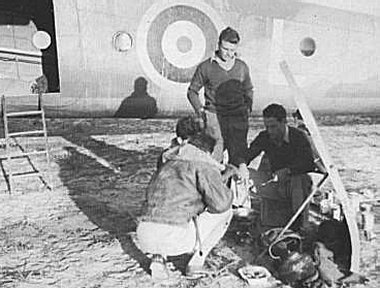
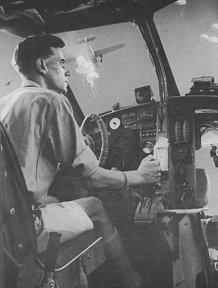
Much of the Bombay’s work was dropping supplies by parachute.
WWII LONG RANGE METEOROLOGICAL
FLIGHTS
By Keith Campbell keithcam@telusplanet.net
John: Ted Hackett said that I should send you
a bit about Met. flights. I flew with 1402 Met. Flight in Aldergrove, Northern
Ireland in Hudsons, then on 518 Met. Sqdn., Isle of Tiree, Western Scotland,
and finally on 520 Met. Sqdn., Gibraltar. We had Merlin powered Halifaxes
on the squadrons.
(Information purloined from my late Met. Observer, Jim
Yates.)
Understandably, weather is an important factor in flying.
Initially, local Royal Air Force stations made hourly weather observations
which were sent to a central command for compilation into a general forecast.
However, the vast majority of northwestern Europe's weather develops over
the Atlantic Ocean Naval ships sailing the Atlantic were aware of their
weather, but had to maintain radio silence for safety and security reasons.
So their observations remained "on board" until the ships docked.
In 1940, the Royal Air Force provided twin engine aircraft to carry out
long range weather observations over Atlantic waters. The various weather
observations were made at sea level "stations", which were 50 nautical
miles apart. After the ninth station, the aircraft climbed, with observations
made with every drop of 50 millibars in air pressure, until, if possible,
a pressure of 500 millibars was reached (about 5.5 km above sea level).
The weather observations were put into coded groups which were transmitted
by the wireless operator to a central command.
The aircraft then returned to near sea-level and began
the return to base; the "met" observer continuing to make and record observations.
The unsent weather information was transmitted from home base to the central
command. ( The crew of the twin engine aircraft was a pilot, a navigator/met.
observer, and two wireless operator/air gunners, one at the wireless set,
and the other in the gun turret.) Longer range flights began in September
1943, after several squadrons of four-engine Halifax aircraft were formed,
and the crews trained. A crew of 8 was made up of two pilots, one navigator,
one met. observer, one flight engineer, and three "WAGs", one at the wireless
set, the others in the two gun turrets. The range was extended to 14 stations
before the "boxed" ascent to 500 millibars was begun. The prepared coded
information was then transmitted to the central command. The flight continued
at 500 millibar height, toward home base, for 5 stations.
After a boxed descent to near sea level, the met. observer
continued the observations of weather conditions. Flight duration was about
10 hours. Weather was considered so vital that radio silence was
not kept. Also, the daily flights took off regardless of the weather, I
know of no flight that was ever cancelled because of bad weather.
CORRESPONDENCE
Dear sir,
I was wondering if any of your members have any recollections
of Sumburgh or Sullom voe with a view to writing a book regarding Shetland
military aviation,
Thank you,
Iain Morrison.
In the December 2001 Page, Sandy Sanderson
told us about two teachers in Belgium, whose hobby is excavating WWI and
WWII aircraft crash sites, and how they found the .50 caliber mid-under
gun which Sandy was manning when their Halifax crashed in Belgium.
The following is a letter from one of these men.
Dear Mr Moyles,
Thank you very much for your most welcome letter. I apologize
for my late reaction, but exams at school and holidays with the family
immediately afterwards prevented me from keeping up to date with my correspondence.
Wim Huyghe and I were very grateful for the help Sandy Sanderson and 3
other crewmembers of the ill fated Halifax LW394 gave us in our research
of what had happened on February 9, 1945 in Voormezele.
I am writing an article in English on this event and the
recovery of LW394 which I will send to everyone interested. So, I will
certainly send a copy of it to your address as well. I would like to finish
the text by the end of January, or close to the memorable date of 9 February.
I have downloaded your very interesting website on the
Internet and read Sandy's newsletter. Yes, the finding of the .50 cal.
mid-under gun was really the pick of the bunch. At the end of August this
year it was to be seen on a display about WWI an WWII in Flanders together
with other pieces of wreckage of LW394 (amongst others one of the three
motors that we could dig up) & other aircraft that crashed in our country
during the war.
Thank you very much for contacting me and I would like
to keep in touch.
Meanwhile I wish you a Happy New Year.
Sincerely Yours,
Dirk Decuypere
tel. 056 51 56 25
A quick note John to let you know I've had a number of
responses to
my query about mid-under guns. I really appreciate the
effort you guys have
made on my behalf. I especially can't say enough about
Phil Dubois who has
gone out of his way to help including sending me a photo
of a mid-under gun as
well as a hand-drawn sketch. Great guy! Hope to meet
him one day.
Cheers
Jay Hammond
Nelson, BC
Jay.Hammond@gems2.gov.bc.ca
Doug Linder, a games designer with Mad
Doc Software is developing a video game involving WW 11 aircraft and in
the December issue he requested information on the mechanism that prevented
the mid-upper gunner from shooting his tail off.
Ted Hackett replied:
I have some information that I hope will be of
help to you. The Fraser-Nash mid-upper turret was surrounded by a raised
portion of the aircraft fuselage, it looked like it was sitting in a well
from some angles. At the front of the turret were two rods and rollers
called "the operating levers and rollers". The rollers rode on the
fuselage and when the guns came in line with a portion of the aircraft
they would ride up on a raised portion and deflect the gun(s) upwards.
There were two levers and rollers so I presume each one operated one gun.
The diagram that I have is from an Air Ministry Publication and it does
refer to a "gun fire interrupter" that is described in another publication.
I spoke to several members of the ex-Air Gunners at our last luncheon but
most of them seem to have been rear gunners or flew in the Halifax or the
Stirling, and memory does fade after 50 odd years. I have a couple of photographs
that show the levers and rollers, although not too well, but I have been
having a problem with my scanner. One of my grandchildren, who are
more at home with computers than I am, is going to come up and help me
and, when he does, I will send the photos to you, hopefully before too
long.
Hope you had a good Christmas and that the New Year will
be good to you.
Cheers, Ted Hackett.
Doug Linder’s reply:
Hi Ted,
Thanks so much for the detailed information. I'm
sure it will be a lot of help to the artists making the model of the aircraft.
Photos are nice, but if it's a lot of trouble, please don't feel as if
you have to go through a lot of effort to get them. It's not critically
important - I just wanted to make sure that we programmed the gun to work
the way it actually did.
Again, we appreciate you taking the time to clear this
up for us. If you want to take a look at what the game will be when
it's finished, please fell free to visit the web page for the game here:
http://www.maddocsoftware.com/games/janes_attack_squadron.asp
Sincerely,
Doug Linder
(Ed. Check this game out for your Grandchildren)
BOOK REVIEW
GROUNDED IN EIRE
by Ralph Keefer
McGill-Queen’s University Press 2001 ISBN 0-7735-1142-3
Hard cover – 263 pages.
Ralph Keefer has given us a vivid, detailed,
well documented account of his Father’s temporary internment in Ireland
during WWII.
From the Author’s Note.
“As a Royal (Canadian) Air Force Pilot during the Second
World War my father (Bobby Keefer) commanded over eighty missions from
September 1940 to April 1945. He served in Bomber Command, Coastal Command,
and Ferry Command. He was awarded the Distinguished Flying Cross for his
efforts.
You can’t experience all of that without picking up a
few stories along the way. One of my Father’s best - an unlikely
story if there ever was one – involved a botched mission to Frankfurt where
he and his friend, Jack Calder, who had been a reporter before the war
and was now his navigator, somehow landed up in an Irish prison camp.”
As the book unfolds we share the experiences of these
Canadians in the internment camp. The inmates were RCAF, RAF, Polish, Free
French, American, and on the other side of a high wall, German internees.
What made the camp so different from the POW camps in Germany was that
the inmates were given Day Parole whenever they wanted it. They signed
a declaration at the gate promising not to escape while on parole, if they
did there were dire consequences. However, on returning to camp and surrendering
the document they were free to plan and attempt to escape as it was their
duty so to do. We read of their experiences on parole e.g. golfing, fishing,
enjoying the hospitality of upper class society in the County, and frequenting
the local pubs. On a number of occasions P/O Keefer took part in fox hunting
- riding with the hounds with a charming Irish girl instructing him on
the etiquette of the occasion. The German’s were given the same privileges
leading to interesting results. The Officer’s Mess on the camp even had
a well stocked bar!
The book tells of the numerous escape attempts, some successful,
some not. In all cases the Germans were cheering for the guards.
The story is well documented with pictures of the area,
some taken during the internment, and many official memos and letters
from government officials. The book gives the reader some insight into
Irish history.
I’m not going to tell you if Bobby Keefer and his friends
escaped, you will have to read that for yourself. I found GROUNDED
IN EIRE a very interesting, humorous read. It is one of the “theaters of
war” we seldom hear about, I recommend it highly for your WW 11 library.
John Moyles
EDITOR'S NOTES
Reports have been coming in advising that the
November 2001 Page is not in the archives. Our Web Master, Bill Hillman,
has the answer:
“Greetings, John:
I've checked out the November archive issue... the problem
appears to be that CATP has exceeded their amount of allowable storage
space on the WAVE server.
As soon as I can find a free day I'll take each of the
archived Gunner pages and files off the WAVE server... I'll then register
for an account with AngelFire.com that offer free space and move all the
archived sites over to there. I'll then change all the links throughout
the pages to accommodate this change. and we'll bypass the CATP Wave account.
Meanwhile November will have to stay inactive for awhile...until
the move is complete. Hope this meets with your approval.”
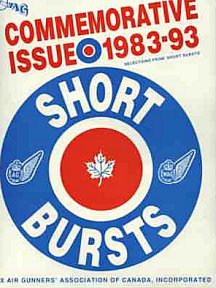 |
Readers will see from this page that the Members have
been responding to the questions and requests for information which have
been received. If you can throw some light on any query we receive please
don’t hesitate to contact the party. Don’t take the attitude, “let Joe
do it”, it is better to get two or three answers, even though they might
duplicate, than none at all. It is encouraging to see that the younger
generation are interested in our history.
Regarding the content of this Page I would like some feed-back
as to the type of content you would like to see. If you wanted it more
Air Gunner related, we could use material from old SHORT BUTSTS. The Bombay
article is taken from the Commemorative Issue – Short Burst 1983 – 1993.
We have a few copies of this 190 page, soft cover, book on hand if anyone
is interested. |
I just spoke to Ellen Penny on the phone and she advised
that Doug is 'hanging in there', no changes and he is feeling pretty good.
Doug Penny was our Association President for 12 years and he did
great PR work for our Association.
As mentioned in the December Issue we will be publishing
a new Page every two months.
The next issue will be on the web April 2002. Your contributions
would be appreciated.
See you in April, Keep well. Cheers,
John Moyles.
BRANCH REPORTS
Northern Alberta
The Christmas luncheon was held on December 12 at the
Norwood Legion with 51 in attendance, not bad for a poor day.
The condition of the roads outside of Edmonton kept a number of members
from attending. The Legion staff did a fine job of providing a great
lunch, turkey and ham with all the trimmings and, since it is a Ukranian
Legion, cabbage rolls etc. The music was supplied by a versatile
two-piece band courtesy of one of the members and a number of members actually
got up and danced. The bank balance is pretty healthy so $200 worth
of door prizes were given away.
The first meeting of the new year was held at the Norwood
Legion on January 3. The members voted to send $35 to John Moyles
to be forwarded to the Brandon Museum to help defray the cost of producing
Shortbursts. At the December meeting we voted to support a local Air Cadet
Squadron and forwarded a cheque for $150 to them, we also renewed our membership
in the Edmonton Aviation Heritage Museum. The members also voted
to renew our membership in the Nanton Lancaster Society and a cheque for
$100 was forwarded to them. We look forward to a good summer and
our President, Svend Jensen, is busy looking for ways to keep us busy.
We hope everyone had a good Christmas and will have a healthy and happy
New Year.
Northern Saskatchewan
Dear John!
On December 10, 2001 we held our Ex A.G.'s & W.A.G.'s
Christmas Supper at the Lynx Wing. There were 30 people in attendance.
Harry Thompson said grace and at the conclusion of grace we kept our heads
bowed in memory of Howard Hitchcock and Shirley Corbett. Special guests
in attendance were Les Kell and his wife. The meal was a traditional Christmas
supper. Harry Thompson introduced the entertainment, an RCAF film
re Pilot training.
On January 21/02, at noon, 26 of our Members sat down
to a delicious lunch of soup, sandwiches, and dessert.
It was god to see Jack Scarfe in attendance and improving
in health.
We will meet again on Monday, Feb. 3rd.
C. A. “Smokey” Robson.
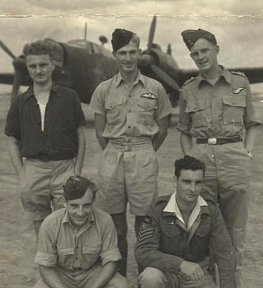
1944 Foggia India
L to R – Pilot Peter Judd Australian
Navigator Stev. McCann
Bomb aimer Fergus Mennie
Wop/AG Ted Rainer
Rear Gunner Dick Farley
Picture submitted by Ted Rainer
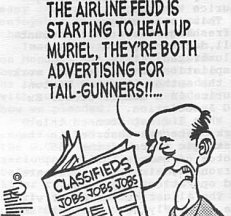
Regional Meetings
Southern Ontario Chapter
Royal Canadian Legion
Wilson Branch 527
948 Sheppard Avenue West
Downsview,Ontario
We meet the first Wednesday of each month at the Legion hall 1:00
pm.
No meetings July, August, September.
Contact persons:
Ken Hill ~ President ~ 905.789.1912
Bill Cockburn ~ Secretary ~ 416.492.1024
Email: piperbill@home.com
Winnipeg
Location - Royal Canadian Legion Br.#4 St. James Legion.
Date - Second Thursday of each month.
Time - Luncheon meeting (provide your own lunch).
Contact Member - Charlie Yule Ph. (204) 254-6264.
Northern Saskatchewan
Location - Lynx Wing Ave. C North, Saskatoon.
Date - Third Monday of the month.
Time - Luncheon meetings.
Contact Member - C.A. "Smokey" Robson Ph. (306) 374-0547.
Northern Alberta Branch
Location - Jasper Place Legion , 10220 - 156 St. Edmonton.
Date - Third Tuesday of each month.
Time - 12:00 hours.
Contact Members - E. H. "Ted" Hackett (780)962-2904
or Sven Jensen (780)465-7344.
Southern Alberta
Location - Royal Canadian Legion #264
Kensington, Calgary
Date: Second Monday of each month.
Time - 11:30 hours.
Contact Member: Dave Biggs Ph: (403)236-7895
or Doug Penny Ph: (403)242-7048.
Note:
October meeting time moved to third Monday.
Also there are no meetings in July and August, however, a Barbecue
is usually held at Larry Robinson's ranch in Okatoks during that
time.
British Columbia Branch
Meeting time and local: 2nd Tuesday of each month at 12 noon,
Canadian Legion, 4896 Delta, Ladner, B.C. (no eating facilities)
Contact person - Dave Sutherland
Ph. (604) 431-0085
E-mail distilledwater@home.co
Members across the Country are encouraged
to
send current information regarding
regular meeting places, dates, and Contact
Members, to
John
Moyles
Box 6
Kenosee Lake
SK S0C 2S0
Members are requested to send their experiences, articles, anecdotes,
pictures, etc., to John Moyles and I will forward them to our Web Master
in Brandon. Articles and Last Post items will be deleted from the page
each month after the designated Member in each region has had an opportunity
to copy the material for their Members. Notices of deceased Members are
to be sent to Charlie Yule who is still our 'Keeper of the Rolls'. This
is your SHORT BURSTS with no printing or mailing costs, and no deadlines!
We thank our Web Master, Bill
Hillman, for his volunteer time and expertise.
|




Webmaster:
William G. Hillman
BILL
& SUE-ON HILLMAN ECLECTIC STUDIO
Editor and Webmaster Bill Hillman
~ Copyright 1996-2021
©
2008 Bill Hillman and Ex-Air Gunners Association











